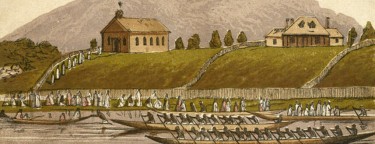There are 70,000,000 Methodists world-wide
These resources were produced by the Faith and Order Committee and Mission Resourcing.
The presence of Methodism in Aotearoa can be dated back to the early 19th century. For nearly 200 years the Methodist movement has taken various shapes and forms, attempting to carry out Gods work in the face of an ever changing nation and world. From the first Mission Station in the early 1820's, to today's commitment to being a bi-cultural, multicultural church, the story of our church is fascinating and unique.
-
The Wesleys
John and Charles Wesley were sons of the vicarage. Their parents, Samuel and Susannah were both from Anglican backgrounds. Samuel’s father and grandfather had been ordained before him. Susannah’s father, Dr Annesley, was one of the leading non-conformist ministers in London at the time. Both parents were well-educated and they taught all their children to read and write in English, Greek and Latin. Both parents were creative and wrote poetry and music.
At Oxford University John and Charles began their journey towards the creation of the Methodist church, establishing a Holy Club of people who wanted to meet regularly for fellowship, prayer and study. They were very methodical in their practice. They visited the poor and the sick, took communion regularly and fasted twice a week.
The Wesley brothers went on to be ordained, and were invited to go to Georgia to minister in Savannah and to the ‘natives’. Things did not go well and they returned to London. A few months later, each brother had a spiritual experience, where he felt, for the first time, an assurance that God loved him and that he was saved. After spending some time with the Moravian church, they began their own societies. The Anglican Church did not accept them, so John and Charles, and the new societies preached in the open air and in their own buildings, making thousands of converts through their enthusiasm, their singing and their challenge for changed lives. One hearer, an Anglican rector, wrote to John Wesley, “Your way of thinking is so extraordinary that your presence creates awe, as if you were an inhabitant of another world.” [Whitelamb, rector of Wroote]
The Methodist church grew out of a need to organise and formalise the new societies. Chapels were built. There was a system of membership, with tickets that were renewed every three months (if you were still worthy). The Class Meeting was established for regular meetings of small groups for prayer, study and fellowship. To organise the church, the Wesleys established a Conference to meet regularly, with John Welsey in the chair.
-
How and when did Methodism come to New Zealand?
Some of the first Europeans to come to New Zealand were Methodist missionaries. The Methodist emphasis on personal salvation and social responsibility both played a part in bringing the missionaries to these shores. The first mission was at Kaeo in Northland in 1823, set up by the Wesleyan Methodist Missionary Society in Britain. More missions were set up in the 1830’s and 1840’s in such places as Hokianga, Manukau, Kaipara, Kawhia, Waipa, Mokau and New Plymouth in the North Island, and Waikouaiti and Cloudy Bay in the South Island.
A Native Institution was established in 1845 to train Maori ministers to serve Maori communities. By 1858 10% of New Zealanders were Methodist (a higher proportion than in England), and by 1850 there were 22 Methodist ministers in the country.
In 1874 the church became independent of the British Conference and had its own annual Conference in New Zealand. Until 1910 this reported to the Australian Conference every three years.
On Being Methodist: Information Pack
- Methodism in New Zealand Historical note
- The Treaty of Waitangi
- What is a Methodist? by Keith Rowe
- Methodist Involvements
- Social Principles of MCNZ
- Methodism Ethos by Donald Phillips
- Wesleyan Economics Insights for the 21st century
- Behind the Scallop Shell
- A Methodist Understanding of Marriage by Rev Dr Trevor Hoggard

The people called Methodist trace their foundation to a group of enthusiastic Christians who were inspired by the Holy Spirit to go out into their country and preach the good news, transform lives and then nurture the newly converted. We stand in their shadow and are charged to do just the same in our own age.


